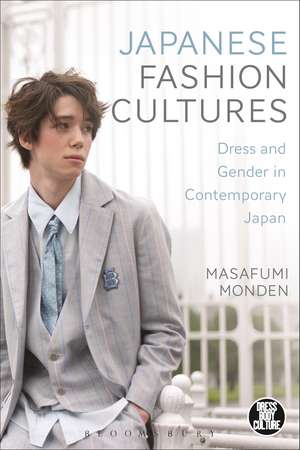Japanese Fashion Cultures: Dress and Gender in Contemporary Japan: Dress, Body, Culture
Autor Masafumi Mondenen Limba Engleză Paperback – 19 noi 2014
| Toate formatele și edițiile | Preț | Express |
|---|---|---|
| Paperback (1) | 178.65 lei 6-8 săpt. | |
| Bloomsbury Publishing – 19 noi 2014 | 178.65 lei 6-8 săpt. | |
| Hardback (1) | 714.51 lei 6-8 săpt. | |
| Bloomsbury Publishing – 19 noi 2014 | 714.51 lei 6-8 săpt. |
Din seria Dress, Body, Culture
- 11%
 Preț: 218.91 lei
Preț: 218.91 lei - 7%
 Preț: 193.62 lei
Preț: 193.62 lei - 9%
 Preț: 694.49 lei
Preț: 694.49 lei - 11%
 Preț: 218.66 lei
Preț: 218.66 lei - 21%
 Preț: 172.95 lei
Preț: 172.95 lei - 23%
 Preț: 177.49 lei
Preț: 177.49 lei -
 Preț: 151.54 lei
Preț: 151.54 lei - 7%
 Preț: 149.02 lei
Preț: 149.02 lei - 13%
 Preț: 183.10 lei
Preț: 183.10 lei - 6%
 Preț: 151.41 lei
Preț: 151.41 lei - 11%
 Preț: 217.53 lei
Preț: 217.53 lei - 14%
 Preț: 180.44 lei
Preț: 180.44 lei -
 Preț: 257.03 lei
Preț: 257.03 lei - 12%
 Preț: 241.42 lei
Preț: 241.42 lei - 7%
 Preț: 187.26 lei
Preț: 187.26 lei - 14%
 Preț: 178.22 lei
Preț: 178.22 lei - 7%
 Preț: 179.98 lei
Preț: 179.98 lei - 17%
 Preț: 193.02 lei
Preț: 193.02 lei - 24%
 Preț: 654.77 lei
Preț: 654.77 lei - 13%
 Preț: 202.66 lei
Preț: 202.66 lei - 13%
 Preț: 189.02 lei
Preț: 189.02 lei - 14%
 Preț: 173.62 lei
Preț: 173.62 lei - 11%
 Preț: 217.09 lei
Preț: 217.09 lei - 13%
 Preț: 237.75 lei
Preț: 237.75 lei - 18%
 Preț: 264.63 lei
Preț: 264.63 lei - 13%
 Preț: 196.19 lei
Preț: 196.19 lei - 11%
 Preț: 217.09 lei
Preț: 217.09 lei - 39%
 Preț: 277.23 lei
Preț: 277.23 lei - 13%
 Preț: 225.96 lei
Preț: 225.96 lei - 22%
 Preț: 714.19 lei
Preț: 714.19 lei - 22%
 Preț: 715.42 lei
Preț: 715.42 lei -
 Preț: 191.31 lei
Preț: 191.31 lei - 14%
 Preț: 178.22 lei
Preț: 178.22 lei - 13%
 Preț: 232.25 lei
Preț: 232.25 lei - 11%
 Preț: 218.91 lei
Preț: 218.91 lei - 22%
 Preț: 713.21 lei
Preț: 713.21 lei - 14%
 Preț: 715.89 lei
Preț: 715.89 lei - 12%
 Preț: 237.59 lei
Preț: 237.59 lei - 14%
 Preț: 178.15 lei
Preț: 178.15 lei - 22%
 Preț: 716.89 lei
Preț: 716.89 lei
Preț: 178.65 lei
Preț vechi: 207.01 lei
-14% Nou
Puncte Express: 268
Preț estimativ în valută:
34.19€ • 35.56$ • 28.22£
34.19€ • 35.56$ • 28.22£
Carte tipărită la comandă
Livrare economică 15-29 aprilie
Preluare comenzi: 021 569.72.76
Specificații
ISBN-13: 9781472532800
ISBN-10: 1472532805
Pagini: 216
Ilustrații: 15 bw illus
Dimensiuni: 156 x 234 x 13 mm
Greutate: 0.34 kg
Editura: Bloomsbury Publishing
Colecția Bloomsbury Academic
Seria Dress, Body, Culture
Locul publicării:London, United Kingdom
ISBN-10: 1472532805
Pagini: 216
Ilustrații: 15 bw illus
Dimensiuni: 156 x 234 x 13 mm
Greutate: 0.34 kg
Editura: Bloomsbury Publishing
Colecția Bloomsbury Academic
Seria Dress, Body, Culture
Locul publicării:London, United Kingdom
Caracteristici
Includes case studies never before examined in the Japanese and English speaking worlds, from music videos to celebrities
Notă biografică
Masafumi Monden is Lecturer in Japanese Studies at the University of Western Australia.
Cuprins
1. Introducing Japanese Fashion, Past and Present2. Lost in a Gaze: Young Men and Fashion in Contemporary Japan3. Boy's Elegance: A Liminality of Boyish Charm and Old-World Suavity4. Glacé Wonderland: Cuteness, Sexuality and Young Women5. Ribbons and Lace: Girls, Decorative Femininity and Androgyny6. An Ivy Boy and a Preppy Girl: Style Import-Export7. Concluding Japanese Fashion Cultures, Change and ContinuityBibliographyIndex
Recenzii
Masafumi Monden's fascinating and important book, Japanese Fashion Cultures, will be of great interest to everyone interested in fashion, gender, globalization, and youth culture. His research on young Japanese men and their attitudes towards fashion is especially significant, as it calls into question persistent stereotypes about how men and women are assumed to engage with fashion.
From the possibility of subversion in lace-trimmed Lolita outfits and petite pinafores straight out of Alice in Wonderland, to the enchantments of Milkboy dandyism, Masafumi Monden's Japanese Fashion Cultures offers up a delightful combination of case studies that reveal the very best thinking in fashion theory today.
Masafumi Monden's book is a gem. By bringing together and exploring colourful examples from Japan's vibrant street culture and fashion, he artfully demonstrates just how individualistic, innovative, and original the Japanese are. He also dismantles myths and misperceptions about gender relations, sexuality, and social relations in Japan.
Monden provides a rich and detailed examination of the subtle intricacies of gendering and sexuality in contemporary Japanese fashion. While exploring the extremes of Tokyo street fashion he is able to illuminate some of the mechanism behind the perplexingly divergent ways to be a man or a woman in today's Japan.
Fashion trends are inherently transitory and intrinsically fragmented. Yet Monden sees sufficient continuities and commonalities within the world of contemporary Japanese fashion to warrant a search for significant social and cultural insights. In his four case studies, he examines fashion magazines aimed specifically at young men, the reasons behind the style choices of two female 'idol' singers, the seeming discontinuities between outward appearance and hardheaded individuality present in the heroine of a well-received film, and the long-term success of 'Ivy Style' among both men and women in the world of modern Japanese fashion . his work upends conventional expectations by intuiting, for example, that fashion-conscious young Japanese men might well be rejecting the blue suit, white shirt and tie style typical of the conventional Japanese 'salaryman' rather than exhibiting a kind of feminized masculinity . Summing Up: Recommended. Upper-division undergraduates and above.
Here is fascinating insight into the 'boyish charm' of Japanese menswear labels such as Milkboy. . Suddenly, as an American, I am given new insight into the semiological logic of a style which one might have assumed to be uniquely American- the logic of 'dressing down' without actually dressing down; indeed, 'dressing down' to demonstrate 'old money' status. . I for one have learned a lot.
For anyone interested in the development of Japanese fashion, contemporary Japanese styles or more broadly the ways in which men and women negotiate the fluid nature of fashion or the representation and negotiation of gender through fashion, this is a valuable and fascinating read.
From the possibility of subversion in lace-trimmed Lolita outfits and petite pinafores straight out of Alice in Wonderland, to the enchantments of Milkboy dandyism, Masafumi Monden's Japanese Fashion Cultures offers up a delightful combination of case studies that reveal the very best thinking in fashion theory today.
Masafumi Monden's book is a gem. By bringing together and exploring colourful examples from Japan's vibrant street culture and fashion, he artfully demonstrates just how individualistic, innovative, and original the Japanese are. He also dismantles myths and misperceptions about gender relations, sexuality, and social relations in Japan.
Monden provides a rich and detailed examination of the subtle intricacies of gendering and sexuality in contemporary Japanese fashion. While exploring the extremes of Tokyo street fashion he is able to illuminate some of the mechanism behind the perplexingly divergent ways to be a man or a woman in today's Japan.
Fashion trends are inherently transitory and intrinsically fragmented. Yet Monden sees sufficient continuities and commonalities within the world of contemporary Japanese fashion to warrant a search for significant social and cultural insights. In his four case studies, he examines fashion magazines aimed specifically at young men, the reasons behind the style choices of two female 'idol' singers, the seeming discontinuities between outward appearance and hardheaded individuality present in the heroine of a well-received film, and the long-term success of 'Ivy Style' among both men and women in the world of modern Japanese fashion . his work upends conventional expectations by intuiting, for example, that fashion-conscious young Japanese men might well be rejecting the blue suit, white shirt and tie style typical of the conventional Japanese 'salaryman' rather than exhibiting a kind of feminized masculinity . Summing Up: Recommended. Upper-division undergraduates and above.
Here is fascinating insight into the 'boyish charm' of Japanese menswear labels such as Milkboy. . Suddenly, as an American, I am given new insight into the semiological logic of a style which one might have assumed to be uniquely American- the logic of 'dressing down' without actually dressing down; indeed, 'dressing down' to demonstrate 'old money' status. . I for one have learned a lot.
For anyone interested in the development of Japanese fashion, contemporary Japanese styles or more broadly the ways in which men and women negotiate the fluid nature of fashion or the representation and negotiation of gender through fashion, this is a valuable and fascinating read.











